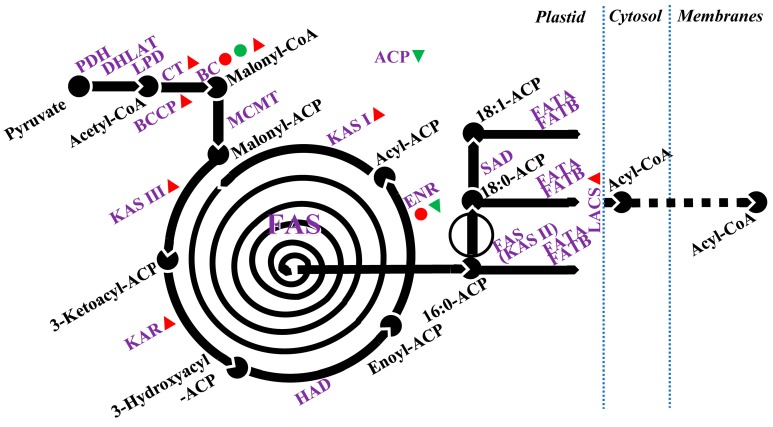Figure 2.
Pathway for fatty acid synthesis, elongation, and export. Information adapted from Li-Beisson et al. [163]. Partial intermediate products are not shown. Dotted blue line represents the division of different subcellular components. The symbols ●, ●, ▲ and ▼ indicate upregulated proteins, downregulated proteins, upregulated transcripts, and down regulated transcripts, respectively, by salt stress, reported in the publications listed in Table 6. De novo fatty acid synthesis begins from an acetyl-coenzyme A (Acetyl-CoA) generated from a pyruvate catalyzed by pyruvate dehydrogenase, dihydrolipoyllysine-residue acetyltransferase (DHLAT), and dihydrolipoamide dehydrogenase (LPD). Biotin carboxylase catalyzes acetyl-CoA to produce malonyl-CoA. Fatty acids are elongated by sequential condensation of two-carbon units by enzymes of the fatty acid synthase complex. To generate a C16 fatty acid, the cycle needs to be repeated seven times and several enzymes are involved, including ketoacyl-ACP synthase (KAS) I, II, and III, ketoacyl-ACP reductase (KAR), hydroxyacyl-ACP dehydrase (HAD), and enoyl-ACP reductase (ENR); acyl carrier protein (ACP) is a cofactor in all reactions. Fatty acyl thioesterase (FAT), stearoyl-ACP desaturase (SAD), and long-chain acyl-CoA synthetase (LACS) are required for fatty acid elongation and transport to other organelles.

